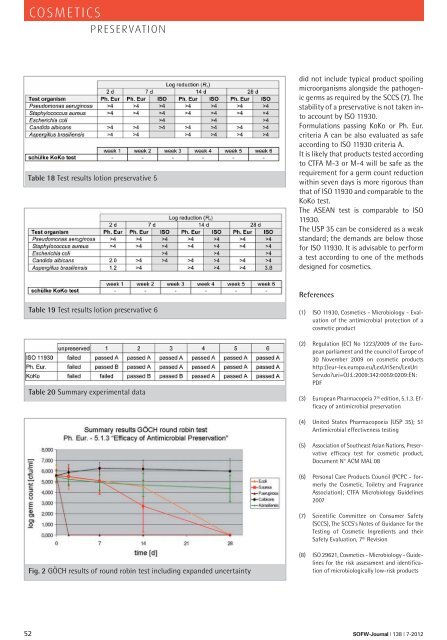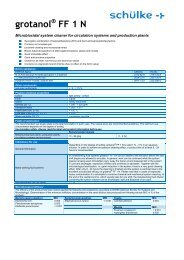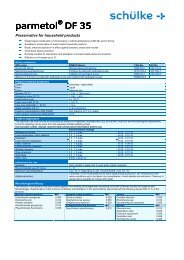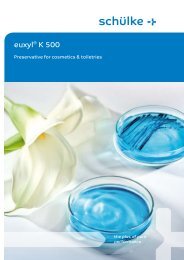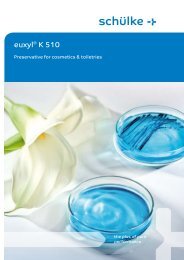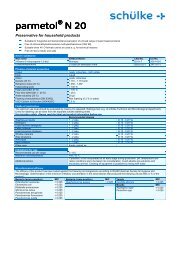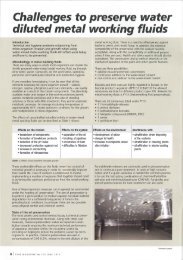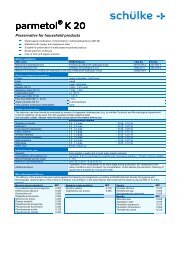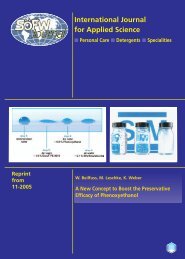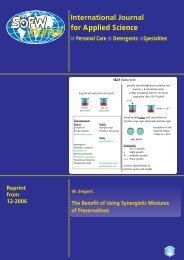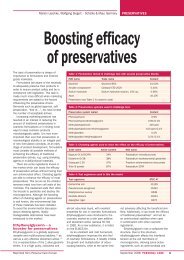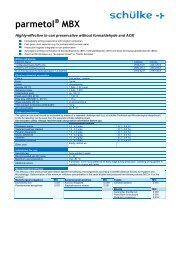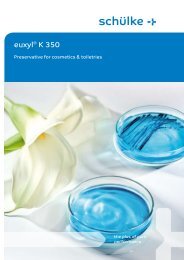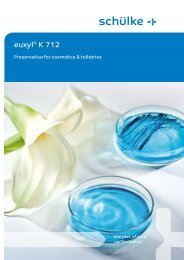ISO 11930 â A Comparison to other Methods to ... - ResearchGate
ISO 11930 â A Comparison to other Methods to ... - ResearchGate
ISO 11930 â A Comparison to other Methods to ... - ResearchGate
You also want an ePaper? Increase the reach of your titles
YUMPU automatically turns print PDFs into web optimized ePapers that Google loves.
COSMETICS<br />
PRESERVATION<br />
Table 18 Test results lotion preservative 5<br />
did not include typical product spoiling<br />
microorganisms alongside the pathogenic<br />
germs as required by the SCCS (7). The<br />
stability of a preservative is not taken in<strong>to</strong><br />
account by <strong>ISO</strong> <strong>11930</strong>.<br />
Formulations passing KoKo or Ph. Eur.<br />
criteria A can be also evaluated as safe<br />
according <strong>to</strong> <strong>ISO</strong> <strong>11930</strong> criteria A.<br />
It is likely that products tested according<br />
<strong>to</strong> CTFA M-3 or M-4 will be safe as the<br />
requirement for a germ count reduction<br />
within seven days is more rigorous than<br />
that of <strong>ISO</strong> <strong>11930</strong> and comparable <strong>to</strong> the<br />
KoKo test.<br />
The ASEAN test is comparable <strong>to</strong> <strong>ISO</strong><br />
<strong>11930</strong>.<br />
The USP 35 can be considered as a weak<br />
standard; the demands are below those<br />
for <strong>ISO</strong> <strong>11930</strong>. It is advisable <strong>to</strong> perform<br />
a test according <strong>to</strong> one of the methods<br />
designed for cosmetics.<br />
References<br />
Table 19 Test results lotion preservative 6<br />
Table 20 Summary experimental data<br />
(1) <strong>ISO</strong> <strong>11930</strong>, Cosmetics - Microbiology - Evaluation<br />
of the antimicrobial protection of a<br />
cosmetic product<br />
(2) Regulation (EC) No 1223/2009 of the European<br />
parliament and the council of Europe of<br />
30 November 2009 on cosmetic products<br />
http://eur-lex.europa.eu/LexUriServ/LexUri<br />
Serv.do?uri=OJ:L:2009:342:0059:0209:EN:<br />
PDF<br />
(3) European Pharmacopeia 7 th edition, 5.1.3. Efficacy<br />
of antimicrobial preservation<br />
(4) United States Pharmacopoeia (USP 35); 51<br />
Antimicrobial effectiveness testing<br />
(5) Association of Southeast Asian Nations, Preservative<br />
efficacy test for cosmetic product,<br />
Document N° ACM MAL 08<br />
(6) Personal Care Products Council (PCPC - formerly<br />
the Cosmetic, Toiletry and Fragrance<br />
Association); CTFA Microbiology Guidelines<br />
2007<br />
(7) Scientific Committee on Consumer Safety<br />
(SCCS), The SCCS's Notes of Guidance for the<br />
Testing of Cosmetic Ingredients and their<br />
Safety Evaluation, 7 th Revision<br />
Fig. 2 GÖCH results of round robin test including expanded uncertainty<br />
(8) <strong>ISO</strong> 29621, Cosmetics - Microbiology - Guidelines<br />
for the risk assessment and identification<br />
of microbiologically low-risk products<br />
52 SOFW-Journal | 138 | 7-2012


